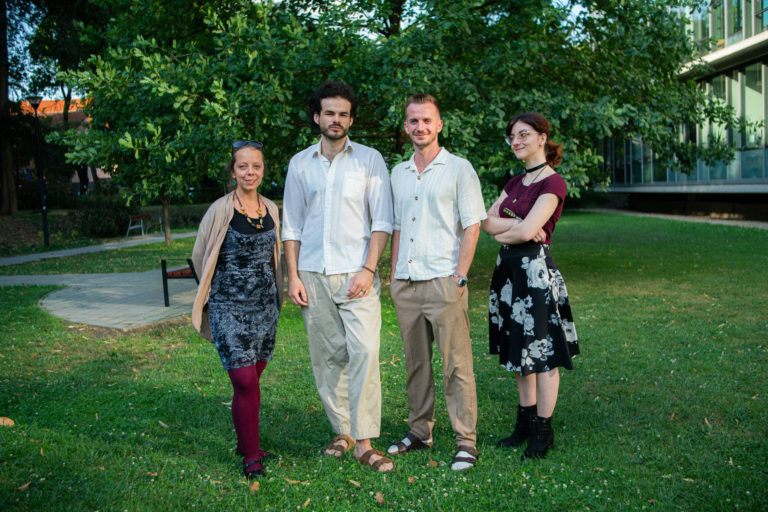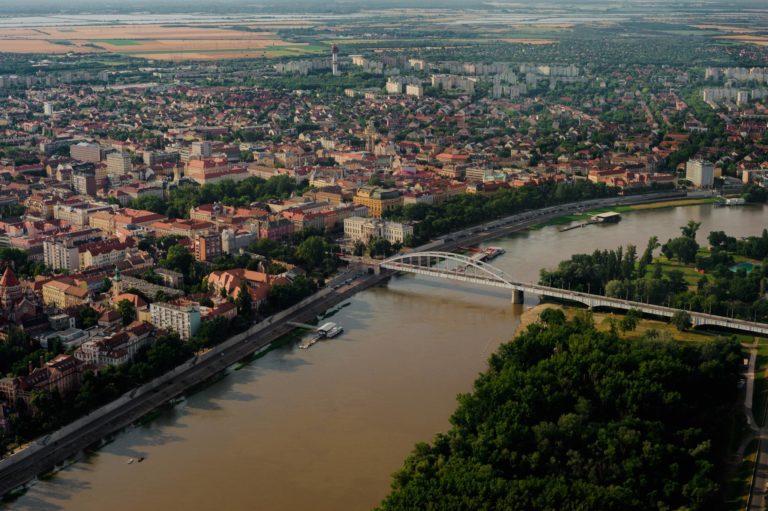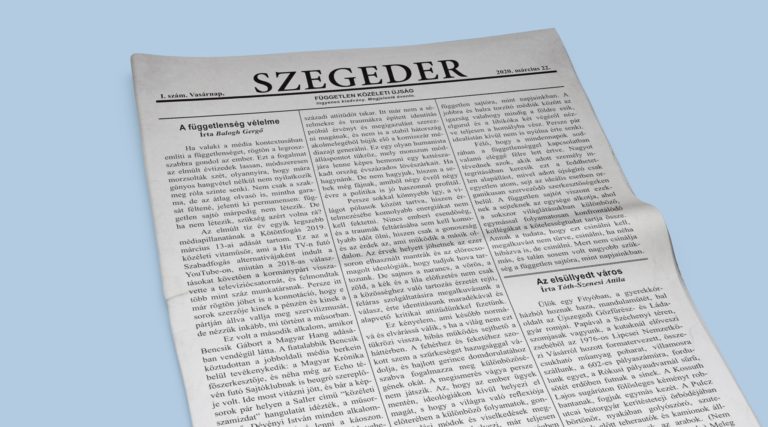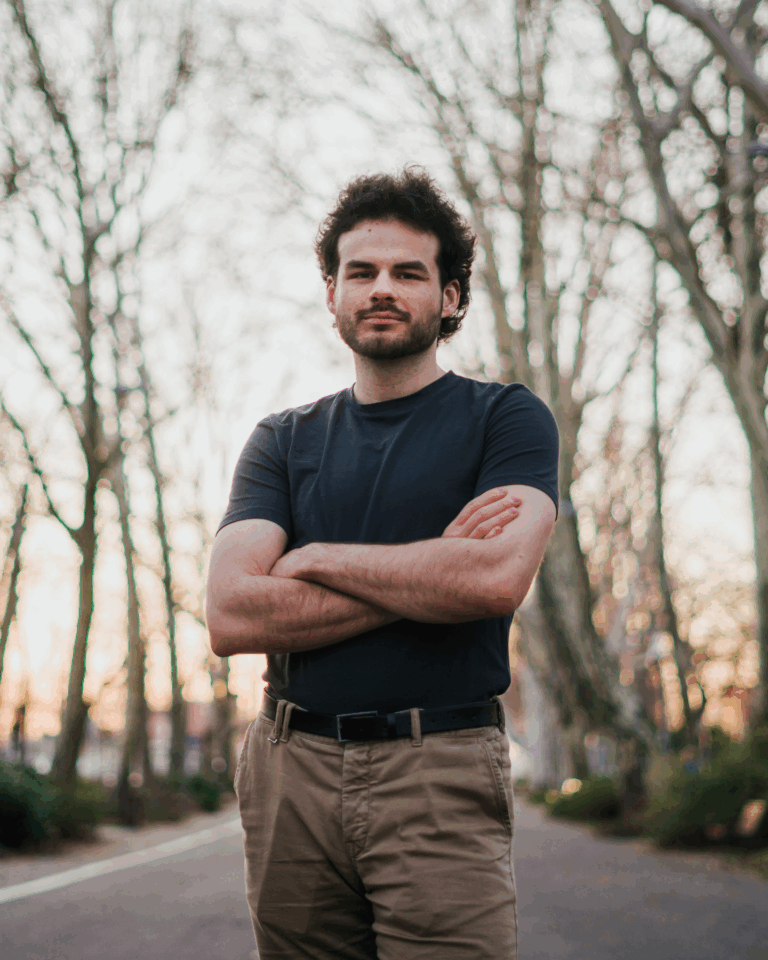“Without Independent Press, There Can Be No Free City”
Author: Nora Balkanyi
What began as a solo blog by a university student in 2017 has grown into one of the best-known independent newspapers in Hungary’s southern region. In Szeged, the country’s third-largest city, Szegeder now operates with a 20+ member editorial team, persevering amid both global and local challenges.

Szegeder's team – © Nora Balkanyi
“Without independent press, there is no free city.” This spring, Szegeder plastered this slogan across Szeged—population roughly 160,000—on stickers and posters. “When everything is going well, people don’t notice it as much, but when those in power overstep their bounds and ignore the handbook of democracy, it is primarily the local press that must stand guard at the city limits,” says founder and editor-in-chief Dániel Szűcs.
When It Rains, It Pours
Hungary is top-heavy, with its capital serving as the country’s dominant creative and cultural hub. The largest independent newsrooms—both established legacy outlets and newer digital players—are based there. Viewed through the so-called and long-standing ‘urban–folk dispute’, a familiar political split emerges: the countryside along with its towns and cities have traditionally been strongholds of the conservative right, led by the ruling party Fidesz for more than 15 consecutive years, while urban areas and especially the capital lean toward the left-liberal opposition. Budapest has been governed by an opposition mayor since 2019, Gergely Karácsony.
Thanks to the peculiarities of the Hungarian electoral system, Fidesz gained unprecedented power when it won the 2010 elections with a two-thirds parliamentary majority. It then started to build the corrupt “System of National Cooperation” (NER) and began dismantling democratic checks and balances. The media played a key role in this process: in its first year, the government passed a new media law and started to reshape the market in its own interests[1].
Today, a well-oiled propaganda machine operates across the state-controlled and captured media landscape—spanning print, online, radio, television, social and influencer networks—deploying e.g. the familiar “firehose of falsehood” method. Over the past 15 years, independent outlets have been taken over, rendered unviable, or simply shut down.

Szeged – © Adras Balint (Szegeder)
Even so, the resilience of the free press—sustained by its traditions, quality, and forced creative problem-solving—has led to innovative models: partial paywalls, subscription systems, reader donations, community events, grants, and branded products. Even new projects arose with educational intent to teach the next generation of journalists. The oppression and the will to take action against it also produced new, passionate, and value driven players rooted in civil or artistic fields.
The media network operating outside of Budapest starkly illustrates these processes. Since the second half of the 2010s, county newspapers have been turned into centrally edited propaganda sheets, while the emerging independent newsrooms in larger cities maintain contact and build up strategy. Global challenges compound their problems: algorithm-driven social media distribution, shrinking ad revenues siphoned off by tech giants, the rapid spread of AI tools, and politicians building up their own media platforms—to name a few old and new problems, not mentioning the ongoing economic pressures.
All this makes the work of the remaining local independent media—telling local stories for local audiences—particularly vital. The situation requires a significant amount of work from particularly dedicated, enthusiastic workers with a special, often personal bond to their homes since Budapest and the EU naturally attracts talents and offers wider working opportunities in the creative industry.
Close to the Serbian and Romanian borders, Szeged stands out. Known for its opposition-leaning politics and left-wing mayor (László Botka) since 2002, it might seem like a friendlier environment for an independent outlet. Yet Szegeder’s staff note that their independence only means that when criticism comes, it comes from all sides.
At the time of writing, the fate of the independent press is highly uncertain, overshadowed by the so-called transparency bill and the looming spring elections.

Szegeder special 2020 print issue – © Szegeder archives
Too Many, Not Enough
In 2022, Szegeder had already reached two-thirds of the figures in terms of readership data formerly produced by the old county paper. The editor-in-chief told me back then that sometimes he thinks “the victim pose is bigger than the real problems.” Smiling wryly today, Szűcs adds: “Maybe reality has caught up with us since then”.
Founded in 2017 as a one-man blog—self-funded and initially focused on urbanism—Szegeder expanded into covering public affairs. It began as a sole proprietorship, joined by a few colleagues in 2019, and received a major grant from the Open Society Foundations’ European programme in late 2020 (an organisation the government frequently targets for its ties to George Soros, stating it serves “foreign interests” ). The outlet’s biggest growth spurt came in 2022, and it has continued steadily since.
When Szegeder launched, Szeged’s only newspapers were aligned with either the government (Délmagyarország, Szegedma) or the municipal opposition (Szeged.hu). A new outlet, Szeged365, later entered the market in the spring of 2020, branding itself as independent, though Szegeder staff argue it functions more as an advertising platform. Notably, its founders worked on a Fidesz campaign prior to launching the paper.
“There may be too many local newspapers for a town of 160,000, but that doesn’t mean any should disappear,” says Szűcs. “We all need to adapt so people still want to read local news alongside TikTok—or discover it there.” New media, such as video and podcast formats remain rare in the region.
“Our possibilities are limited, but we are ambitious about developing Szegeder,” Szűcs adds. “At the start, everything was quite ad hoc and over time old processes solidified—now it’s time to shake things up, rearrange the bricks, maybe bring in new ones.” A recent internal survey asked every staffer to describe the kind of paper they’d most like to work for. “I’m really curious to see what comes out of it.”

Szegeder's team – © Luca Szabo
Expensive and Precarious
From a handful of contributors, Szegeder has grown to 20–25 staff, with a core of seven or eight prioritising it each week and the rest working other jobs or studies. Today alongside the creative team, it has dedicated roles for finance and strategy. It has also transitioned legally into a foundation, with the finance colleague taking on the significant administrative workload that is typical in Hungary.
The growing annual budget comes from grants (now—being typically international—threatened by the ‘transparency bill’), content partnerships, advertising revenue, and reader donations—with the latter making up 5-10%. The team hopes to expand this source, while also experimenting with subscriptions. Thanks to its new foundation status, the paper was able to launch its first ever 1% campaign this year[2].
The consciously planned four-month campaign—online and offline—generated positive feedback from readers. It was a major milestone, as the entire team present at the interview agreed: alongside Szűcs, Annamária Petró (finance/project management), Hanna Koller (journalist/editor), and Levente Szűcs (strategy/operations). “To reach our goals, we need high-quality, engaging, locally rooted content,” says Dániel Szűcs of the campaign. “We also have to pair that with smart communication. We must remind people how expensive and precarious what we do is.” For him, the key is to make readers feel that their involvement in supporting free press has a tangible impact on the city.
About having that impact, he recalls a story close to him about a 97 years old industrial water tower threatened to be demolished. After discovering a similar building from the 1930s was protected in Zagreb, Szegeder repeatedly questioned the owner MÁV (the Hungarian State Railways), until the plan was halted. “The national press wouldn’t touch a story like this.”
Another remarkable story is Hanna Koller’s: last November, she covered the Novi Sad railway station canopy collapse, which killed 16 people and had major political repercussions. “We met other Hungarian reporters, but we were the only ones from Szeged. That’s when I realised how important our role is—reporting firsthand to our community on what happens in our close neighborhood.”
When asked whether Szegeder differs from other countryside independents because of Szeged’s opposition leadership, Szűcs says “we’re similar in size to others but follow a different model—working with many university students who are agile and flexible. They’re a young, dynamic team. Sounds like corporate-speak,” he laughs “but it’s true.”
Together with independent outlets from other significant Hungarian cities like Pécs, Debrecen, Kecskemét, Miskolc, Nyíregyháza, or Veszprém, Szegeder is part of Fülke (Society of Independent Local Newspapers), which meets regularly for professional and moral support. “That’s essential,” says Szűcs, “especially when the latest ‘how we’re going to destroy you’ draft law drops.” The editor-in-chief adds it's good to know that they are not alone, and that there are five or six other small islands in the country struggling with very similar problems.
“We called each other not long ago when the ‘transparency bill’ dropped. We had a good laugh,” he adds ironically. The members talked about considering similar steps. “The obvious alternative is to move the organisation's headquarters across the border. If it were just a matter of distance, we would go to Timișoara in Romania, but I hope we won't have to. That's still up in the air.”

Dániel Szűcs – © Andras Balint
Independence as Prerequisite
In Hungary, the label ‘independent’—often paired with ‘objective’—has a political charge. Fidesz politicians and media workers frequently mock newsrooms that adhere to traditional journalistic principles such as balanced reporting, editorial autonomy, and watchdog scrutiny of those in power, claiming those ‘on the other side’ push a hidden agenda under the independent label.
From a strategic point of view, Szegeder’s independence means diversification. “No single grant, reader, or advertiser should dominate,” emphasises Levente Szűcs. “I am here precisely to increase independence in the long term.” Hanna Koller stresses that independence and balance are not the same, even if it’s often confused with one another: “Being independent doesn’t mean being balanced or objective. Balance is a choice—independence is the prerequisite for making it.”
Annual reader surveys show the share of respondents who see Szegeder as independent—and it grows each year. The most recent one surpassed 79,3%.
The quotes in this article have been edited for clarity.
References
[1] A wealth of Hungarian and foreign material documents the issue and its reasons, including works by journalists, data-driven analyses, academic papers, political reports, civil society studies, podcasts, etc. E.g. : A Media System Abandoned by Mérték Media Monitor, 2024; Hungary’s Media Ownership Country Report by Euromedia Ownership Monitor and its references, 2022
[2] In Hungary, taxpayers can donate 1% of their taxes to a civil or church organisation of their choice. However, the ‘transparency bill’ threatens to remove this valuable source of funding from the civil society. Results are expected in September.
Published on September 2nd, 2025
About the author:
Nora Balkanyi is a journalist based in Budapest, covering creative industry, media, and culture; currently freelancing as an editor at hvg.hu, media literacy trainer and cultural content manager; volunteer in JazzaJ hub for improvisational music since 2015; the proud granddaughter of a Szeged citizen from long-ago.